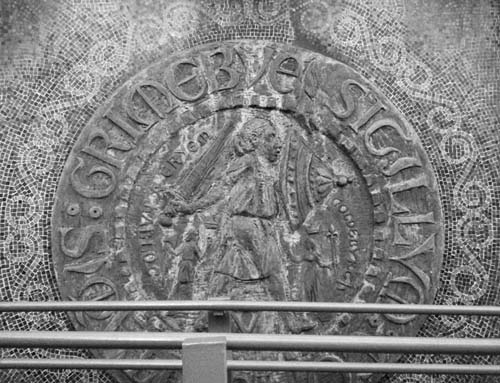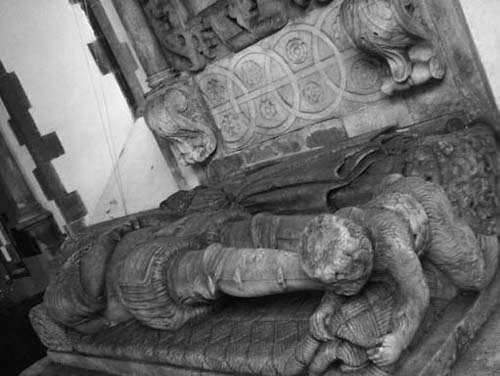Read Folklore of Lincolnshire Online
Authors: Susanna O'Neill
Folklore of Lincolnshire (14 page)
The Havelok Stone can be found within the grounds of the Welholme Galleries, Grimsby. The site is an old church, situated along the B1213, Welholme Road, between Hainton Avenue and Intax Mews.
News of Havelok’s great might soon reached the ears of Earl Godrich, who had as his ward Goldborough, daughter of the late King Athelwold. Once of age, Godrich had promised to marry Goldborough to the strongest man in the land. Athelwold, obviously meant a king or prince, but Godrich took this opportunity to marry her off to the servant lad Havelok, therefore ensuring his own son would be heir to the throne instead of her. The two were forced to marry, both resenting the fact bitterly, but fate was to thwart Godrich, as Westwood explains:
…one night she [Goldborough] saw a light shining from her husband’s mouth as he lay asleep. She saw, too, a cross on his shoulder, which the voice of an angel explained was the mark of a king, prophesying that Havelok would rule both England and Denmark.
3
After questioning Grim about this secret and discovering the truth, Havelok and his new wife travelled to Denmark and overthrew Godard, Havelok claiming his rightful throne as king. Then they invaded England and defeated Godrich, apparently burning him to death. Havelok became King of England as well as Denmark, thus fulfilling the prophecy. It is told that Havelok and Goldborough lived happily ever after with their fifteen children and ruled together for sixty years.
The old seal of Grimsby depicts this tale, showing Grim as the central figure, the founder of Grimsby, with his sword and shield at the ready to defend the boy, Havelok, and the town. The hand of providence hangs above him, guiding his actions. On either side of him are Havelok and Goldborough, their crowns suspended above them indicating their royal standing. A mosaic of the seal decorates the outside wall of the Grimsby Central Library, a grand sight, except for the disabled ramp which unfortunately covers the bottom of the creation.
There is another legend of a kind-hearted Lincolnshire giant, Tom Hickathrift, whose abode was in the marshland around the Wash. Possibly of Saxon descent, he was described as a huge fellow possessing considerable strength. Polly Howat claims that at the start, Tom was rather a lazy fellow and that all he did was sit around the fire at home and eat all day, much to the exasperation of his poor, widowed mother.
4
She says that at just ten years of age he was already a 6-foot tall giant, 3 feet wide, eating as much as five normal men. He did posses great strength though; he allegedly kicked a football so hard that no one could ever find it.
One day a local farmer offered Tom’s mother some fresh straw for her mattresses and told Tom to come and collect as much straw as he could carry. The poor farmer was soon eating his words, as Tom reluctantly followed him and came home with most of the field upon his back. Soon people from far and wide knew of his strength and he was eventually bribed into taking a job with a brewer, who had him trekking twenty miles across the marshes every day with a cart load of beer.
The
Lincolnshire Life
magazine tells of a second giant who was living in another area of marshland and was terrorising all the locals and anyone who happened to pass through.
5
He would rob them and strike fear into everyone’s heart. One day,
Tom Hickathrift decided to take his cart over this area as a shortcut. The giant tried to attack him and Tom defended himself by rapidly removing the wheel and axle from the cart and using them as a club and shield. The two giants had a ferocious fight and Tom overcame his assailant, cutting off his head and leaving the villagers forever freed from his domination. Tom was labelled a hero and it is said he was called on from near and far to fight other giants who were causing trouble. Eventually he was apparently knighted for his good deeds and given the land of the first giant he fought, where he built a comfortable home for himself and his mother. Howat adds that he donated some of his land to the poor, on which they built a church dedicated to St James, as it was on the feast day of this saint that Tom had originally killed the giant.

The Grimsby seal mosaic at the entrance of the Grimsby Central Library.

Tilney All Saints remembers Tom Hickathrift’s victory by depicting his immense frame on their village sign.

Possibly the final resting place of the giant Tom Hickathrift, a large tomb-like stone, now placed just outside the east door of the Tilney All Saints’ Church.
There is another version, narrated on the fascinating website of Mike Burgess,
6
which he apparently sourced from a 1631 publication,
Ancient Funerall Monuments
[
sic
] by John Weever. This account concurs that Tom was working for a King’s Lynn brewer and that it was while he was driving his cart of beer across the marshland that he came upon a heated dispute between the inhabitants thereof and
their landlord. Tom supposedly saw that the common people’s liberties were being infringed and felt such outrage that he tore the axel from his cart and saw off the landlord and his men, leaving the inhabitants free to enjoy their land. It seems unclear as to whether this was the original version of events or if, in fact, there really had been a vicious ogre terrorising the people. Either way Tom was classed a hero, with many ensuing adventures. He was said eventually to have teamed up with another huge chap, Henry Nonsuch, and together they defeated many foes.
As in many other legends, not least that of Robin Hood, there is a story that Tom himself determined where he should be buried when his time came to go. He threw a stone from his house, which is said to have landed just to the east of Tilney All Saints’ churchyard. Here, an unmarked 8-foot stone slab lies at right angles with the pathway – perhaps the place Tom is now buried (especially if he shrunk a little in death!).
Around 300 years ago, a Wild Man of the Woods is said to have been spotted in the then heavily forested area around Stainfield. Myths of the Wild Man of the Wood, also known as the Woodwose, abound all over Europe – an ancient mythological figure; a huge, hairy man known to dwell amongst the trees; a guardian of the forests, not dissimilar to the Green Man – therefore it is not surprising that his appearance should also grace Lincolnshire.

Monument to Sir Robert Tyrwhitt in Bigby Church, with the Wild Man of the Woods, who he apparently defeated, lying at his feet.
The story tells that the Lincolnshire Wild Man of the Wood was creating rather a nuisance, killing locals and their livestock and so a gentleman named Francis Tyrwhitt-Drake is said to have tracked him down and dispatched him. Daniel Codd relates this tale, adding that there were other reasons this story could have come about and other explanations for his appearance on the Tyrwhitt-Drake coat of arms.
7
However, he does add that in the church in Bigby there is a monument to Sir Robert Tyrwhitt, depicting a giant hairy man lying across his feet – possibly indicating more truth to the story than first believed. The Tyrwhitt Arms at Short Ferry
certainly likes the tale, true or not, and have included the Wild Man, as depicted on the Tyrwhitt-Drake arms, on its pub sign!

The pub sign of the Tyrwhitt Arms at Short Ferry depicting the wild man.
Codd tells of the giant from the Isle of Axholme, William of Lindholme, who was a farmer’s son.
8
The tale implies that the big lad was taken advantage of by his father, who would abuse the boy’s extraordinary strength, making him do all the work around the farm by himself. William naturally resented this and made a few attempts to kill his parents. On one occasion he hurled a boulder into Wroot, where his parents had gone to a party, but his attempt to crush them failed, the rock landing past the house where they were. When they arrived home they reprimanded him severely, not only for trying to kill them, but also for leaving the fields unattended, where the sparrows could attack the crops freely. William replied that he had in fact caught all the sparrows and locked them in the barn, before he attempted murder. On inspection, his parents found this to be true, discovering the barn full of dead or dying sparrows, those left alive having turned entirely white with the shock. They were freed and apparently went on to form a colony of rare white sparrows in the area! Polly Howat adds that it took six strong horses to try and shift the boulder William had thrown, but even then the task was beyond them and the beasts fell down dead from exhaustion. Whispers that the stone was cursed began to spread and it was decided it should be left undisturbed.
…no ones da-ares so much as ter touch the stoo-an, or ter ra-ise it noo, though its nearly gressed o’er. If ever it should get gressed o’er, then, th’ earth’ll be covered wi’ blood! No moss’ll grow on t’ stoo-an, for stoo-an eats it off as fast as it grows.
9
According to Howat’s source in 1976, someone did move the stone but within two years the person suffered a tragic bereavement in his family, the locals putting
the misfortune down to the curse. Gutch and Peacock add that there were two other immense boulders within the vicinity, thought to have been brought there by William, called the Thumb Stone and the Little Finger Stone.
10
